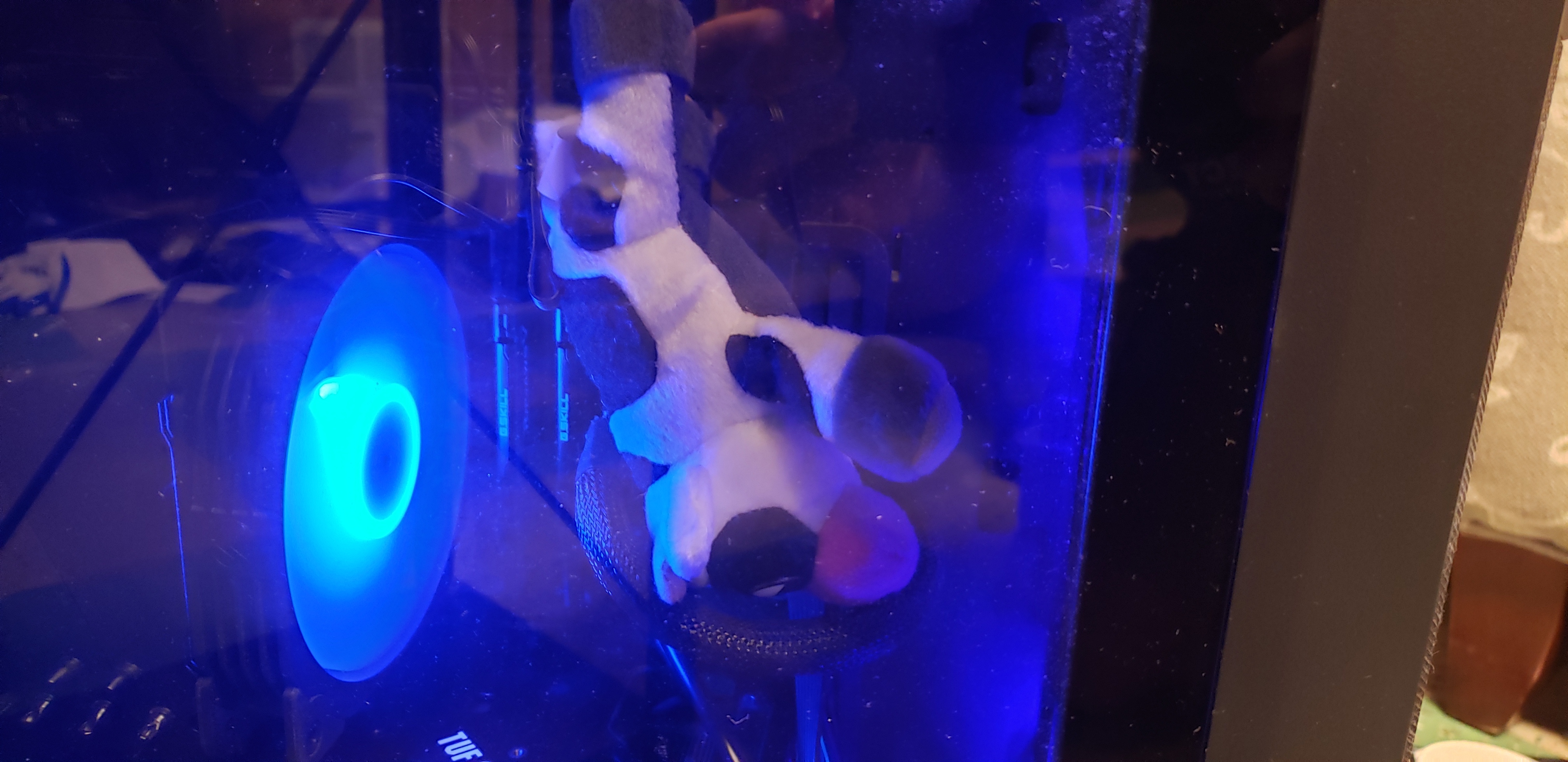Tinkering is all fun and games, until it’s 4 am, your vision is blurry, and thinking straight becomes a non-option, or perhaps you just get overly confident, type something and press enter before considering the consequences of the command you’re about to execute… And then all you have is a kernel panic and one thought bouncing in your head: “damn, what did I expect to happen?”.
Off the top of my head I remember 2 of those. Both happened a while ago, so I don’t remember all the details, unfortunately.
For the warmup, removing PAM. I was trying to convert my artix install to a regular arch without reinstalling everything. Should be kinda simple: change repos, install systemd, uninstall dinit and it’s units, profit. Yet after doing just that I was left with some PAM errors… So, I Rdd-ed libpam instead of just using --overwrite. Needless to say, I had to search for live usb yet again.
And the one at least I find quite funny. After about a year of using arch I was considering myself a confident enough user, and it so happened that I wanted to install smth that was packaged for debian. A reasonable person would, perhaps, write a pkgbuild that would unpack the .deb and install it’s contents properly along with all the necessary dependencies. But not me, I installed dpkg. The package refused to either work or install complaining that the version of glibc was incorrect… So, I installed glibc from Debian’s repos. After a few seconds my poor PC probably spent staring in disbelief at the sheer stupidity of the meatbag behind the keyboard, I was met with a reboot, a kernel panic, and a need to find another PC to flash an archiso to a flash drive ('cause ofc I didn’t have one at the time).
Anyways, what are your stories?
sudo apt remove python3
Thinking I would install a more recent version. 😂
Classic
Installed python3 before it was made the native python on the dist. Half broke everything, including apt & python. So I uninstalled it, and then everything was broken. Finally got python3 reinstalled, and lived with it kindof working & awful distribution updates.
I have finally freed myself of that prison last month, by nuking everything and starting fresh.
You can have both python 2 and 3 on the system. It just depends upon which is the default as to how much you break it 👍 The symlink to
/usr/bin/pythonis the important bit for most software. For deb-based at least, update-alternative is your friend.I’ll happily say I must have overlooked something, but I did try using update-alternatives. I don’t remember all the nuts and bolts from the start, but it involves python3 and distribution upgrades. I spent a good number of nights over the years trying to unmess it up, and am happy to never think about it ever again.
There was definitely a time when python3 was not recommended and plenty of scripts weren’t yet differentiating between the two. Everything was breaking back then.
I deleted bash on my work computer one week into the job 🫠
csh FTW eh 🤣
CTRL-C-ing apt because it looked stuck for more than 10 minutes. I don’t recommend doing it.
Man, gotta love
aptsometimesapt is great, but yeah, if it’s gonna fail, let it fail on its own.
Haven’t used
aptin a while, is it not atomic? What happens if you mess with it?I don’t think it is, if it doesn’t run its course on its own, you’re screwed. It’s Debian so you can recover, but, at least for me, it was painful.
This was pre-linux for me but something you can still do in most distros so I think it’s a valid story.
In 1999 I was using Napster on computer running MS-DOS. I was 12 years old and an aspiring open media enthusiast/stupid script kiddie. I was using the file explorer interface in Napster and accidentally gave access to my entire C drive. I also had opened ports to share certain media and to fuck with my friends using daemon tools (back then you could do stupid stuff like control a friend’s desktop with certain versions of daemon tools). Immediately I started receiving packages called things like “sleep.tight.tiny.mite” and I knew I was fucked so I clicked in the Napster interface and clicked “delete” and deleted my entire active drive.
I panicked and installed the only operating system we had which was a random copy of Red Hat. When my dad came home I pretended like it had always had Linux on it. I do think he was more impressed than mad.
“Just pretend it’s always been Linux” is a bold move. I salute 12-year-old you o7
sudo rm -f /lib /usr/share/backup/blah blah.tar.gz
Note the space.
Oh man, you really owned those libs
You need to use chown if you want to own the libs
Note the past tense
Top tip, if tired, replace the
rm -fpart of the command with something innocuous for a first run. Actually, is better to do this mistake once so that the two important lessons are learned… Backup (obviously, in your case it was backups, but the point still stands) and double check your command if it has potential for destruction 👍Might be recoverable if you had a live distro ready. Otherwise, o7.
Oh no, this was back in the days when we loaded our distros by way of a stack of floppy disks.
sudo apt upgrade -yTo this day I can’t figure out why it killed the GUI and all terminal commands on a Mint install…
I stay away from apt. apt-update for me has never messed like apt has.
I’m relatively new to Mint, but I thought that sudo apt update just checked for updates and sudo apt upgrade -y was for actually installing the updates. I don’t see why that would break it though.
You’re right, I messed up - I always switch between the two, because “update” makes more sense in my head. I fixed the text.
Connect via ssh to my home server from work
Using a cli torrent client to download stuff
Decide I need a VPN.
Install VPN again from CLI
Run VPN which disconnects my ssh connection
Even when I get home, the server is headless so I have to locate a keyboard and mouse before I can fix.
Dang, similar stuff happened to me on nixos. Had to instruct one of the relatives on how to reboot the machine and choose a previous generation in the boitloader 🤣
Same.
I had rEFInd and GRUB installed entirely by accident, and a botched update for Arch hosed my entire EFI setup making it impossible to boot Linux or Windows w/o a LiveCD. Thankfully it self repaired once I nuked rEFInd. I ended up going back to Ubuntu, but I hate snaps. I still would recommend Arch for most Linux users who want the power windows.
I suppose it doesn’t quite qualify as breaking the system in a funny or stupid way but it certainly was one of those stupid things that was easy to fix after a ton of trouble shooting, ignoring the issue for a while and trying to fix it again.
So i had an old pc where I had a failed hard drive which I replaced. Obviously I also accidentally unplugged my optical disc drive and plugged it back in. Now that failed drive was just a data drive so the system should have booted up no problem since the os was on a SSD but instead it got a kernel panic and got stuck at boot. Since it was late I left it at that and came back to that the next day where it would still not boot. So I unplugged the disc drive and looked up what it could be. Tried a ton of different possible solutions but every time I added that disc drive it would panic.
I eventually kind of gave up and just didn’t use that disc drive at all and just had it as a paperweight in the system. Unplugged and all that. When my replacement SSDs for my old data drive and backup drive came in I tried again to get that optical drive working but to no avail. So I unplugged it again, got it all set up and ran into another issue where for some reason Linux couldn’t properly use my backup SSD. So I investigated that as well and trough some miracle found a post on the forum from my Mainboard manufacturer… Turns out that particular Mainboard had a data retention chip on it that didn’t like Linux.
So naturally I just plugged everything into the data ports that were not controlled by that chip and it all worked as intended.
Stupid dumb chip on a Mainboard, all I had to do was try the simple idea of unplugging and trying a different connector but instead I did all that other stuff first that didn’t work and cost me so much of my time.
Moral of the story, when in doubt try and put stuff on different connectors and see if that fixes it. Might just be a dead connector for all you know. Or an incompatible chip on the Mainboard.
FWIW I bought that Mainboard long before I switched to Linux and didn’t plan at all to switch at the time. But that’s a different story.
I once did an apt-get upgrade in the middle of when debian testing was recompiling all packages and moving to a new gcc version. I get it, using testing invites stuff like this. But come on, there should at least be a way to warn people beforehand.
That’s kinda weird: shouldn’t they recompile everything first and then replace repos’ contents?
Me: I want to change my car tire
Car: Hey, your car is going at 60 mph now. Do you want to change your tire now?
Me: Is it not possible?
Car: It’s your car, anything is possible with enough effort. As per Google one guy managed to change a tire of a bullock cart while it was moving at 2 mph.
Me: Sounds good. Let’s gooo!
This is the experience for Linux tinkerers.
In my case it was:
Me: I want to change my car tire, and i naturally assume we are parked safely in the garage. This is a routine maintenance thing after all.
Car: Sure thing! bork
Me: Umm, why are wrapped around a tree?
Car: Well, we were currently going 60mph, and we posted about it on this website.
Me: Why is there no warning that tells me that doing maintenance now will crash my car?
Car: Well like i said, there is, and it is on this website you should have gone to.
and we posted about it on this website.
In my personal experience, these sort of things happen rarely, unless you are using some sort of rolling-release distribution. For all my mission-critical docker apps, I wait for at least a week after a major update has been pushed and check the dev website.
One time I rebooted. The system never recovered.
Actually, I have a story that I’d consider an achievement even though it was extremely stupid and by all accounts should’ve bricked the system but didnt.
So I was on windows and wanted to install linux as a dual-boot on the main drive. The problem was that my mobo didnt like this particular and the only flash drive I’ve had, dropping it out mid-boot, before I got any usable terminal, so a usual install method wasn’t an option. So I had this crazy idea to start a vmware vm in windows and pass the linux iso and the boot drive directly to it and try to install it live over the running system. Unfortunately, vmware guys thought of this and there’s a check that disallows passing the boot drive to vms. So i created a bunch of .vmdks for another drive and fiddled with them in notepad until I somehow managed to trick vmware and at some point it started booting the same windows copy that I was sitting on. I quickly powered it off, added the linux iso and proceeded to install like I usually would. It did involve some partition shuffling, but, somehow, it went smoothly, linux installed, grub caught on, and even windows somehow survived, even though it was physically moved around on the disk. It serms that vmware later patched this out, because later in an attempt to re-create the trick of running the same copy of windows twice, but after updates to both windows and vmware, I was met with the same old error that boot drive is not allowed when trying to add that same virtual drive I had laying around.
Allrighty, now we officially need a program (I’m hesitant to call it malware since technically it’s for the user’s good XD) that covertly replaces a running copy of windows with linux… Besides, I think it was possible before to install stuff like Ubuntu directly from windows?
I had a similar setup once. Dualboot, plus the VM with the same physical disk, to access windows, while running linux.
All it took was a small distraction… I’ve missed the grub timeout, and accidentally booted the same ubuntu partition in a VM that was running on the real HW. To shreds…
I had a similar debacle, when I managed to corrupt a btrfs file system to point it wouldn’t mount again…
I was preparing it to have as my main system on bare hardware. I had accidentally mounted the same block device simultaneously in the host and guest: kablamo silent corruption and all 5 hours of progress lost.* :(
*shred the guest VM, host was ok.
I was running Fedora. Something like 27 or so. I needed drivers. I don’t remember if it was AMD or Nvidia, but they were only available on RedHat.
So I downloaded the RedHat drivers for the GPU and forced it to install. It worked! It was great.
Then when I updated the distro to the next release… everything failed. It was dropping into grub, but no video was output. Ooof.
So I ended up enabling a terminal console and connecting to it via a serial port to debug. I had to completely uninstall that RPM and I was never happy that it was properly gone. So a few months later I ended up reinstalling the whole OS.
On the plus side, I learned a lot about grub and serial consoles. Worth it.
This thread should be renamed to 101 reasons why business give Windows or Macs to their employees.
It’s not like you can’t shoot yourself in the foot while using windows (not sure about macs, tho, but likely just as well). I remember breaking windows countless times while figuring out what service crap can be disabled, removing edge or defender, yada yada.
On the contrary, in my experience, if you’re not actively messing with linux, it’s overall more stable than windows. Like I had to install windows on an actual machine a short while ago, and it was a clusterheck. Drivers failed to auto install (touchpad/trackpoint drivers, for Chaos’s sake), random bsod after an hour or so of normal use, etc. As for linux breaking on itself, I remember like 3 times that happened with me in my ~5 yrs of daily driving different distros, and 2 of those were fixable by switching to a tty (the 3rd didn’t boot, as far as I remember, due to some incompatibility between bedrock and arch).
A system update broke a dependency for libre Sprite, which hasn’t had an update in like two years. You can say they should but let’s be real, my apps shouldn’t break with an update. One of my laptop needs was portable graphics creation. This broke one of my major use cases. Yay.
deleted by creator








